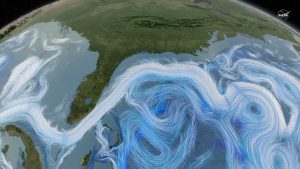 The BBC reports: Sea Level Fears as Greenland Darkens. The article discusses a possible feedback loop where as temperatures warm algae growth may flourish, which darkens the surface and changes the albedo to increase melting.
The BBC reports: Sea Level Fears as Greenland Darkens. The article discusses a possible feedback loop where as temperatures warm algae growth may flourish, which darkens the surface and changes the albedo to increase melting.
One concern now is that rising temperatures will allow algae to flourish not only on the slopes of the narrow margins of the ice-sheet but also on the flat areas in the far larger interior where melting could happen on a much bigger scale.
We joined the latest phase of research in which scientists set up camp on the ice-sheet to gather accurate measurements of the “albedo” or the amount of solar radiation reflected by the surface.
White snow reflects up to 90% of solar radiation while dark patches of algae will only reflect about 35% or even as little as 1% in the blackest spots.
Other highlights from the article include:
Currently the Greenland ice sheet is adding up to 1mm a year to the rise in the global average level of the oceans.
It is the largest mass of ice in the northern hemisphere covering an area about seven times the size of the United Kingdom and reaching up to 3km (2 miles) in thickness.
This means that the average sea level would rise around the world by about seven metres, more than 20ft, if it all melted.
You can get Greenland Ice Data from NASA’s Vital Signs of the Planet page as noted in a past post.

 Where do carbon emissions go seems like an obvious question. Into the air of course. If so, then one would expect a near perfect linear relationship between emissions and atmospheric CO2. The graph here has yearly carbon emissions in million tonnes per year (as reported by the
Where do carbon emissions go seems like an obvious question. Into the air of course. If so, then one would expect a near perfect linear relationship between emissions and atmospheric CO2. The graph here has yearly carbon emissions in million tonnes per year (as reported by the 




